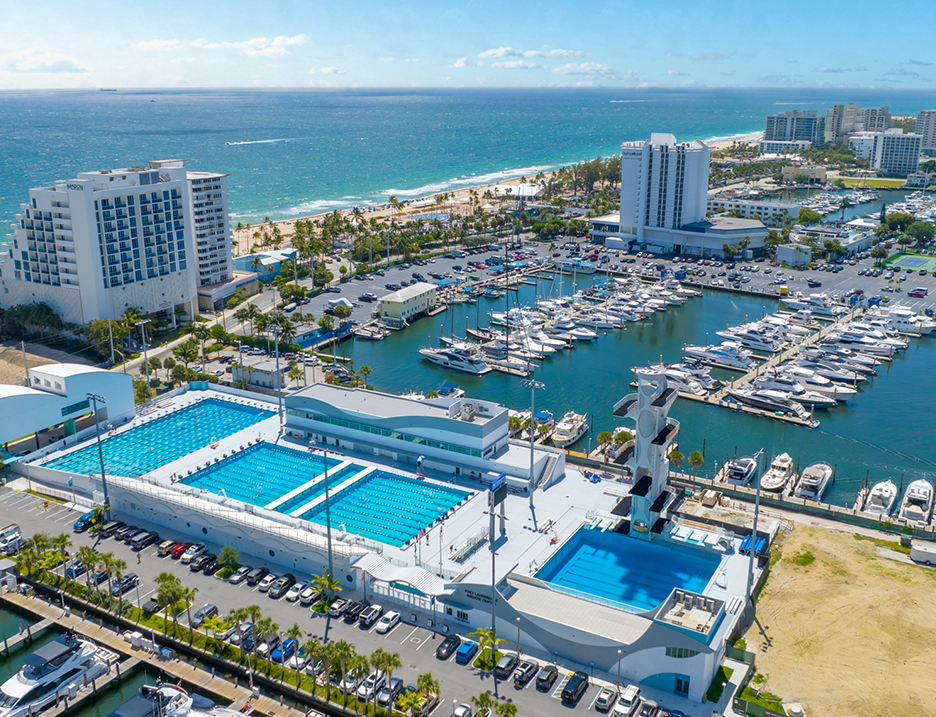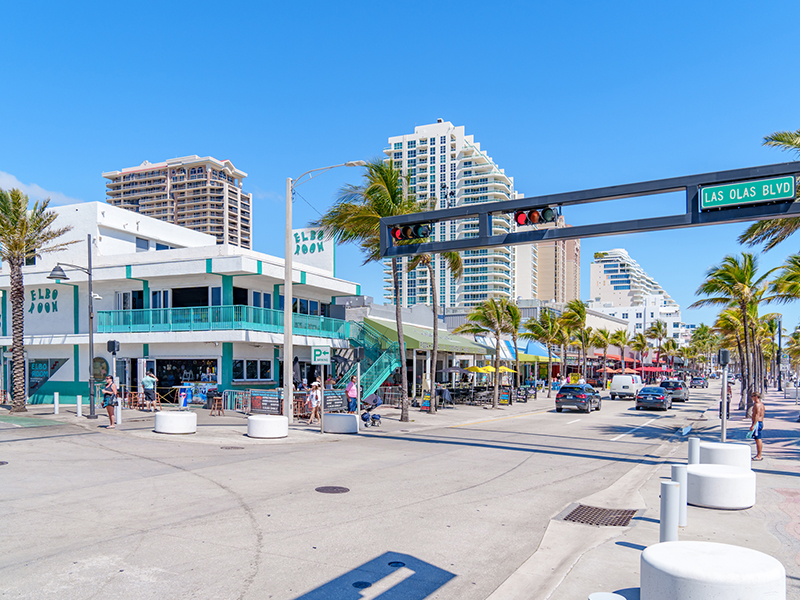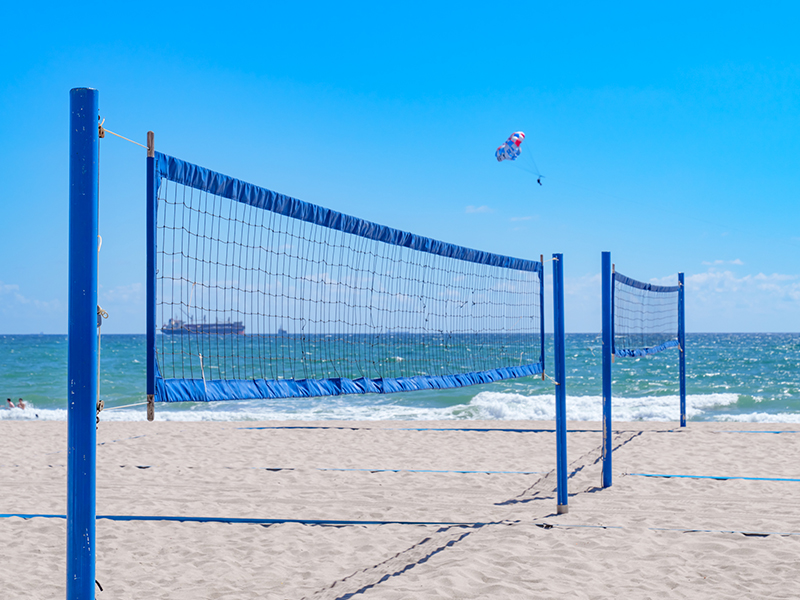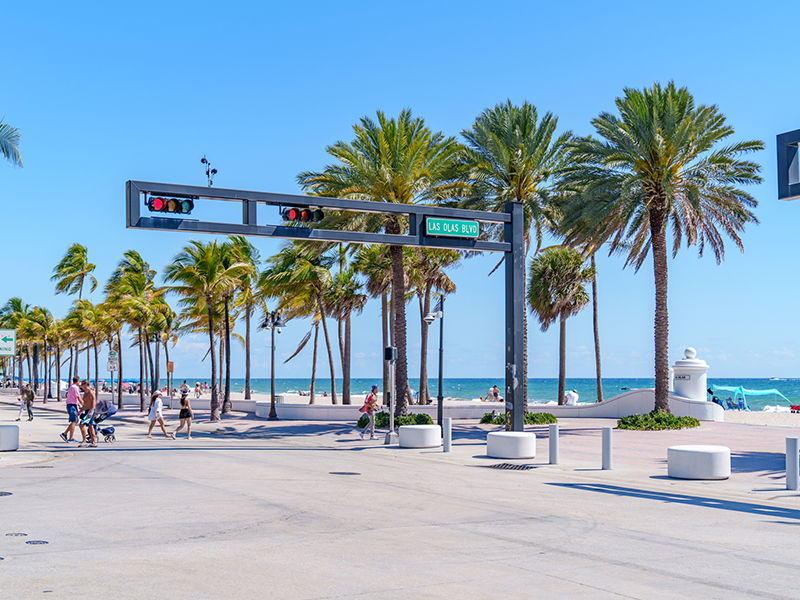
Fort Lauderdale Beach
In 1893, Hugh Taylor Birch a Chicago native, and counsel to the Standard Oil Company, declined an invitation from Henry Flagler to visit Palm Beach. Instead, Mr. Birch decided to head farther south from Hobe Sound in a boat that Henry Flagler lent to him for the journey. Mr. Birch discovered the beautiful New River Sound (today home to Bahia Mar) as he sought refuge from a storm. He was intrigued by the opportunity the area offered, realizing that it would be much better to winter in Florida rather than The Windy City, and he purchased 500 acres of beachside property at what is now known as Sunrise Boulevard for $1.00 an acre.
In 1909, after graduating from Stanford, David Clifford Alexander, from Ohio, came to visit Fort Lauderdale Beach. Seeing the area, the attributes and the beautiful weather, Mr. Alexander realized the potential and in 1913 he purchased a tract of land that spanned from what is now Grenada Street south to what is now the Bahia Mar property. At that time, the only structures on the beach were the home of Hugh Taylor Birch (now Birch State Park), a hunting lodge belonging to Birch’s law partner, John McGregor Adams and a wooden bath house. The area was accessible only by boat until the Las Olas bridge was built. Mr. Alexander donated a small portion of his land to the city, including 100 feet of land located just west of A1A at 501 North Fort Lauderdale Beach Boulevard named DC Alexander Park.
The Las Olas Bridge Company was formed in 1915 by some of Fort Lauderdale’s founders, Frank Stranahan, Tom Bryan and other visionaries to connect the downtown area to the beach via a paved road and a bridge. This project was vital to the area to bring access to the barrier island, thus increasing the boundaries and the recreational opportunities of our emerging city. The bridge project was completed in 1917.
In 1919, as a wedding gift, Mr. Birch transferred ownership of 35 acres to his daughter and her husband, Chicago artist Frederic Clay Bartlett in 1919. In 1920 the newly married couple would begin construction on what would be their winter Florida home. Sadly, construction stopped only a few years later in 1925, when a young Mrs. Bartlett died as a result of contracting breast cancer. Mr. Bartlett traveled to Florida less after her passing until 1931 when he married Evelyn Fortune Lilly. The two of them resumed construction and added many special touches to the beautiful home that is now known as the Bonnet House. This unique and eclectic Florida home is filled with Frederick’s colorful artworks, as well as unusual and whimsical pieces of art all from all over the world.
In 1926, local civic groups rallied to have lifeguards on the beach to protect the swimmers. On December 1, 1926 at 1:30 pm, the first lifeguard reported to his station. The toned physiques of these fine men and women that now guard our beaches proudly bear the name of Fort Lauderdale Ocean Rescue. You’ll see their 20 beach guard towers dotting the sand from the South Beach Picnic Area (across from Bahia Mar) north to the beach in front of Hugh Taylor Birch State Park.
The Las Olas Beach Casino and Pool was a wooden structure, built in 1915 just south of Las Olas Boulevard on the east side of the Intracoastal waterway. This was the first amenity of its kind luring folks to explore this part of the emerging Fort Lauderdale Beach via the new bridge. Only a few years later, in 1927, local architect Francis Abreu designed a new Mediterranean style complex which housed an Olympic-size pool; 165’ x 60’ varying from 3 to 12 feet deep. This remarkable pool was claimed to have been filled several time a week with 420,000 gallons of fresh, filtered salt water pumped by three wells. They claimed the chlorinating system was “one of the best in the south”. The complex also offered a children’s wading pool and plenty of storage lockers for visitors. The pool was touted as the “training ground of champions as well as one of the finest pools in the south.”
In 1935 The Collegiate Aquatic Forum was held at The Las Olas Beach Casino and Pool for 10 days. The event attracted students and swim coaches from 23 schools and facilities that initial year. By the 1950’s the Aquatic Forum event attracted 4,000-5,000 students who came to enjoy this great swim event and take in our luscious, warm spring weather. In the early 1960’s that complex was demolished to make way for the International Swimming Hall of Fame (ISHOF) which was dedicated in 1965. Reimagined over the past few years and now called the Fort Lauderdale Aquatic Center, this impressive complex, with this remarkable Olympic Size municipal pool is home to the first pre-cast concrete dive tower in the world and the tallest permanent high dive platform in the western hemisphere. The platforms range in height from 5M to 27M. The 44 Million Dollar revamp was completed in January of 2023 and now the pool and all of its offerings are open to the public.
Now, back to 1941 when Mr. Birch was experiencing some “friction with the city and county” therefore he was considering deeding some of his property to the state’s park system. He invited Senator Spessard Holland to his Fort Lauderdale estate to discuss this possibility. It was as a result of that meeting that he moved ahead with donating 180 acres and almost one mile along the Intracoastal to the state. He remained living in his home until he passed in 1943, at the age of 94. This expansive, lush, tropical expanse is named Hugh Taylor Birch State Park and was dedicated and opened on January 27, 1951. Mr. Birch bequeathed the remainder, the bunk of his estate; to Antioch College in Ohio. Mr. Birch attended this Liberal Arts College and played baseball there for 3 years but did not graduate from Antioch. This large swath of land given to Antioch became the Sunshine Shopping Center which opened in 1954. By 1957 the property was sold to Charlie Creighton, a businessman and restaurateur for an impressive sum of 14 million dollars. The newly named Sunrise Center was home to Creighton’s Restaurant which enjoyed this location for many years and is now home to what we recognize as The Galleria Mall.
Frederic Bartlett passed away in 1953 but Evelyn continued to winter in the charming home. In 1983, thirty years after Frederic passed, Evelyn Fortune Bartlett gifted the Bonnet House to the Florida Trust for Historic Preservation. At that time, this gift was the largest charitable gift in Florida history. Mrs. Bartlett enjoyed a long life and passed at the age of 110 years in 1997. In 2020, Bonnet House, Inc. bought the house back from the Trust for approximately $886,000. The Bonnet House Museum and Gardens is listed on the National Register of Historic Places since 1984 and the City of Fort Lauderdale declared it a historic landmark in 2002. In 2008, due to the threat posed by massive nearby development, the National Trust and the Florida Trust for Historic Preservation designated the Bonnet House as one of America’s 11 most endangered sites.
I would be remiss if I didn’t include the following slice of our history. An interesting fact that I learned while researching this content is that the nick-name “Fort Liquordale” was first introduced during Prohibition (1920-1933). Bootlegging during the Depression became a viable income source as the locals moved liquor by boat from The Bahamas, other parts of Florida and Cuba.
In the early 1960’s the film “Where The Boys Are” was filmed right here in Fort Lauderdale, on A1A and in the infamous Elbow Room which still stands today. Oh if those walls could talk! As this movie became popular so did this “new” Spring Break destination in SE Florida. The Spring Breaks of the 60’s and 70’s were pure beachside bliss. Many thought (I did!) that this was where the “Fort Liquordale” name was first introduced. During the 70’s some very popular beachside establishments were founded to include, the Button Lounge (1970) popular (for and later punished for) the Eat a Banana As Sensuously As You Can Contest, Wet T Shirt Contests, etc. , The Candy Store (1977) popular for the Itty Bitty Teenie Weenie Bikini Contest and Wet T Shirt Contests. Spring Break just got more and more crowded, popular, and ultimately just purely “out of hand”. During Spring Break of 1985 it’s said that there were 380,000 Spring Breakers on our beaches during the 6 week period of pure debauchery. The “Party Image” which began in the 60’s had grown to such an unmanageable proportion that it was no longer a benefit to our city. Quite the opposite, it had become detrimental. There were just too many alcohol and drug related incidents, some that resulted in death.
By the spring of 1989 the cities concerted efforts to recalibrate the Fort Lauderdale Beachfront image had apparently been successful when only 20,000 student Spring Breakers came to our beaches. Businesses like The Candy Store suffered this loss as the owner stated that his revenue was down by at least 50% that year. His once popular bar languished in the new Fort Lauderdale image. Only The Elbow Room remains standing proud since it first opened in the 1930’s.
The point of reducing the rowdy Spring Breakers was to attempt to “elevate” the Fort Lauderdale Beachfront image from the rowdy Spring Breakers to a more “high end” and even an international clientele. Fort Lauderdale was striving to increase the tax base. They were successful as the Spring Break visitors today are a far cry from the wild party goers of the 70’s and 80’s.
There are few single family residential properties in the north part of the Lauderdale Beach area that I am writing about here. There are only 9 “finger” streets which go west of A1A toward Birch State Park between Sunrise Boulevard on the south border and NE 18th Street on the north border. These properties are priced from 1 million dollars and up. South of Sunrise Boulevard most of the Lauderdale Beach properties are condominium, co-operatives, townhomes, motels and hotels.
Although Fort Lauderdale is a relatively “young city” she sure does offer a very interesting, colorful, diverse and remarkable history. There are many opportunities to learn more.
Sorry we are experiencing system issues. Please try again.




